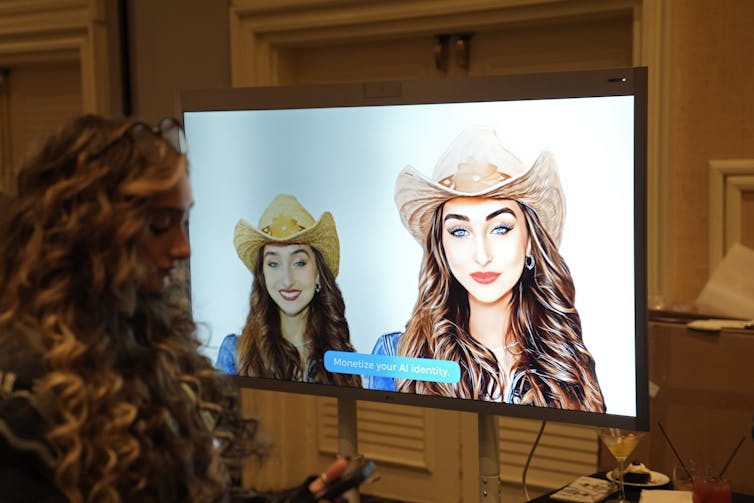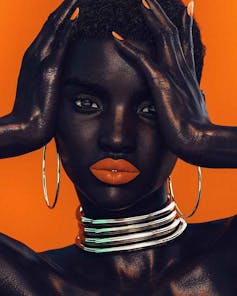In the heart of New York City’s Times Square, there are signs of an artificial intelligence (AI) revolution in marketing. In a health supplement store, a popup by British tech startup, Hypervsn, showcases life-size holograms. From behind the glass, a virtual humanoid avatar with spunky pink hair waves to passersby.
Down the street, H&M — the Swedish fast-fashion giant — offers a new kind of immersive shopping experience. The flagship store showcases a room covered in mirrors equipped with virtual environments, encouraging shoppers to make social media content while they try on merchandise.
And last month, H&M made waves with its newest AI venture: cloning 30 real-life models using “digital twin” technology.
These AI-generated replicas sparked global excitement and debate. But as digital replicas of real people become more common, especially in image-based industries like fashion, urgent ethical questions are emerging. These include conversations about the future of work, compensation and identity in the cultural economy.
H&M
Digital twins, explained
In New York’s bustling AI startup scene, where tech, fashion and finance collide, the potential of digital twins is being met with optimism.
Developers, investors and brands believe that by cloning our human bodies and personalities, we can reach a future in which we live in “double time.” That time would look something like us sinking back into our couch for some rest while our identical avatars show up to work on our behalf. But is it really that simple?
What does it mean for workers whose identities are being cloned without clear guidelines on compensation, ownership and rights?
Digital twin production is a meticulous process that begins with a person’s unique identity. This includes their voice, personality, body and face, all things considered to be their intellectual property (IP).
When someone signs off to be cloned with a digital twin startup, they agree to the use of generative AI replicating everything about their physical body: personal identity, distinct features and skills.
The ethical questions
The emergence of digital twins has forced the development of new ethical frameworks, still in flux. Industry leader Natalie Monbiot, former co-founder of HourOne, has coined the term “Virtual Human Economy” to describe this growing sector.
Companies like HourOne, Synthesia and Soul Machines are competing to dominate this space. They offer digital twins for applications that range from fashion modelling to corporate training videos and online education.
The ethical challenges are significant, particularly regarding ownership.

(AP Photo/John Locher)
The human half of the H&M digital twin models, for example, will receive “fair compensation,” including continued payment for the use of their digital replicas beyond initial creation. The company has said models will retain some rights to how their likenesses are used, but industry standards for such contracts remain inconsistent.
Most digital twin companies establish contracts where the human “original” receives initial compensation for the creation process. This typically involves extensive scanning, voice recording and movement capture.
But such arrangements remain inconsistent across the industry, and the long-term value proposition of these digital likenesses is still unclear.
Some companies offer royalty structures, while others purchase full rights upfront. This raises questions about the fair valuation of a person’s digital likeness.
Traditional image rights contracts, borrowed from the entertainment industry, don’t account for AI’s ability to generate novel content using a person’s likeness. The industry is essentially creating its ethical standards in real time, with some companies adopting more transparent approaches than others.
‘Jackpot’ economy means those at the top take all
For workers in image-based industries, like models and photographers, the rise of digital twins brings a fundamental shift in how labour and compensation are structured. While modelling has always been hyper-competitive, social media has dramatically intensified that and is now playing a large role in how opportunities are allocated.
American labour scholar Andrew Ross pinpoints these dynamics as a “jackpot economy,” where intellectual property becomes “the glittering prize for the lucky few” while the majority face increased precarity.
U.S. fashion scholar Minh-Ha Pham has also written about how digital technologies amplify the winners-take-all economic structures within the fashion and blogging industries. She describes concentrated opportunities and rewards among an elite minority.
To add to this, New Zealand scholars Rachel Berryman and Misha Kavka have demonstrated how the rise of “parasocial” relationships has become increasingly central to career success in these fields. A parasocial relationship describes the sense of intimate connection followers feel toward influencers and celebrities.
In other words, those successful digital twins could further concentrate power among models who already possess substantial followings and cultural cachet. This cachet allows them to multiply their earning potential while those with less visibility struggle to compete against both humans and AI-generated alternatives.
Read more:
AI-generated influencers: A new wave of cultural exploitation
Race, sexuality and gender
This concentration effect is particularly concerning when considering how race, sexuality and gender representation manifests in virtual spaces.

For nearly a decade, fully virtual fashion models like Shudu have become increasingly popular. Shudu has more than 237,000 Instagram followers and partnerships with brands like Balmain, Louis Vuitton and Furla. Shudu and others have demonstrated how digital avatars often flatten and commercialize identity. They present sanitized versions of racial and gender diversity that serve brand interests rather than authentic representation.
While digital twins based on actual humans may provide more authentic representation than fully synthetic avatars, they still risk reinforcing existing inequalities in who receives visibility and compensation.
On the other hand, digital twinning could potentially offer improvements over purely synthetic virtual models.
By maintaining a connection to real human subjects who can negotiate their representation and compensation, digital twins might provide a more equitable approach than computer-generated avatars created entirely at a corporation’s discretion.
Behind the digital glamour are real-life issues
Our collective fascination with technology and the new AI-driven digital twins may be distracting us from a more pressing (but also old) issue. Let’s not forget to look at the economic structures that govern work cultures, human creativity and labour norms.
The debate isn’t just about banning or regulating AI, which enable phenomena such as digital twins; it’s also about how we ensure fair compensation and equitable access to these new forms of labour.
The “jackpot economy” often benefits only a select few, leaving the majority in precarious positions. As digital twins technology continues to evolve, we must develop regulatory frameworks to ensure fair compensation for workers in creative industries.
While we focus on the capabilities and potential of AI, we also need to shift the conversation towards the economic systems and power structures in which these technologies operate.

The post “Fake models for fast fashion? What AI clones mean for our jobs — and our identities” by Jul Parke, PhD Candidate in Media, Technology & Culture, University of Toronto was published on 04/24/2025 by theconversation.com






































Leave a Reply